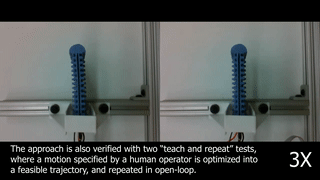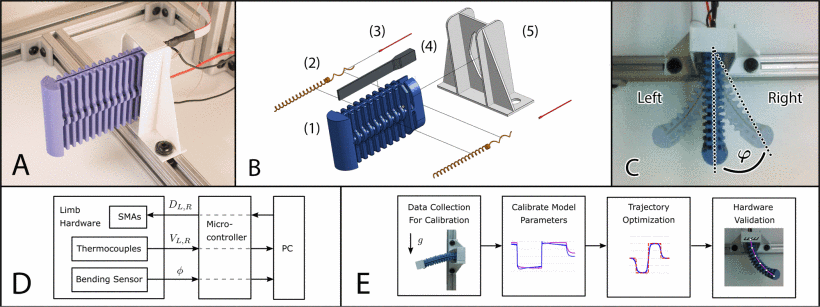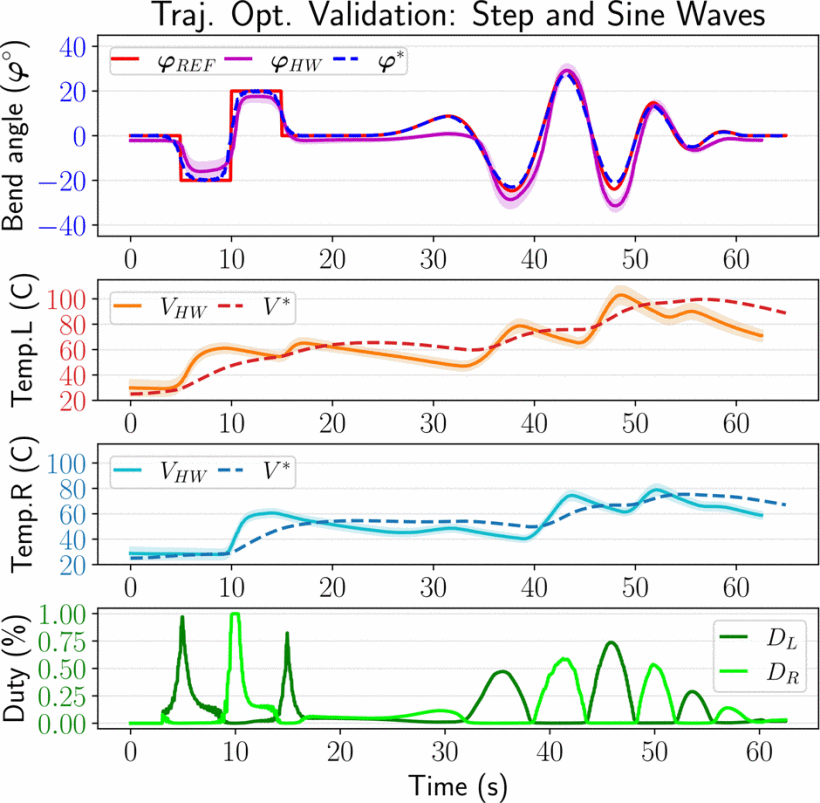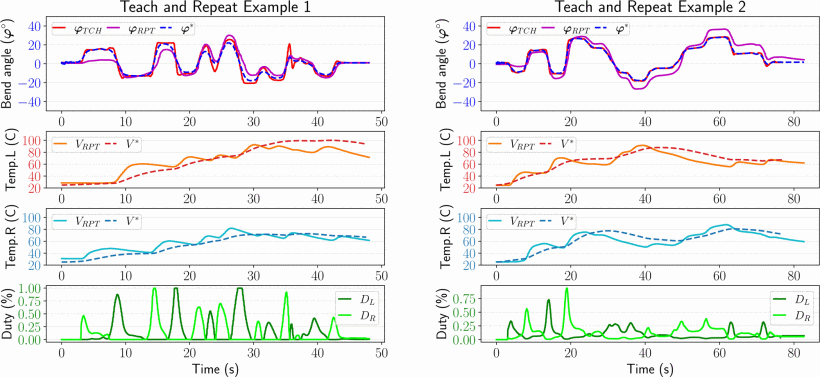Soft manipulator control
Soft robotics in an exciting field of research focused on the design and application of robotic devices that rely heavily on soft materials for their novel functionality. This field presents several challenges:
- Complicated dynamics: Soft devices exhibit significant non-linear dynamics, hysteretic behavior, and time-dependent material property changes, making them more complicated to model than their rigid counterparts.
- Difficult kinematics: Their capacity for significant deformation throughout their bulk, along with limited physical constraints, makes inferring kinematics from available sensing modalities challenging.
- Challenging actuation: The complicated dynamics and sensing, along less precise actuators typically used, make precise control difficult.
Hysteresis is particularly problematic. For instance, a viscoelastic polymer’s stress-strain response differs during the strain phase versus relaxation, resulting in a both non-linear and directionally-dependent stress-strain relationship. This work explores these challenges by evaluating a simplified example of such a system: a single, planar, continuum manipulator.
I had the great pleasure of collaborating with Dr. Andrew Sabelhaus where I investigated more sophisticated models and model-based control methods for his Horton robot. We tackled several key issues on this project including:
- kinematics,
- dynamics modeling,
- model calibration,
- open-loop control, and
- the sim-to-real gap.
Previously, limb motions were laboriously developed by manually tweaking actuator commands until something close to the desired result was attained.
We first looked at representing the manipulator dynamics by modeling it as a discrete, rigid, serial-chain actuator. This takes advantage of the minimal axial strain undergone by the limb by posing constraints that help simplify the dynamics and kinematics. It also allowed the use of standard approachs used in rigid systems.
Then we looked at modeling the dynamics of the shape-memory alloy (SMA) antagonistic actuator pair. SMA is a rigid metal alloy whose crystalline structure can be reversibly modulated by temperature, providing a means of transducing heat to an axial stress. This required two models: on to model the thermodynamic balance between Joule heating and convective cooling; and the other mapping the SMA temperature to an axial stress. This was a challenge as SMA dynamics are complicated and include parameters nearly impossibly to sense non-destructively, so simplifications had to be made.
Once models were developed, we used the physical hardware to calibrate the model parameters. For accurate calibration, we devised a number of scenarios to isolate the individual parameters to fit them with minimal data collection. A dynamics simulator was built to roll out the calibrated model dynamics given an initial state and a control trajectory. This simulation was used in a standard non-linear optimization to design open-loop controls to closely track a user-designed trajectory while satisfying the dynamic constraints. Finally, the process was validated by tracking the designed controls in hardware using a linear quadratic regulator (LQR). You can see an example of our tracking performance in figure 2 which shows the target, simulated, and hardware trajectories.
We extended the work by adding in a “teach-and-repeat” component, where an operator would move the limb along a desired trajectory captured by the device sensors during the “teach” phase. The optimal open-loop controls were again learned to actuate the limb to track the desired trajectory. We validated the procedure in the hardware “repeat” phase, demonstrating a basic form of human-robot cooporation and training. Tracking results for the teach-and-repeat work are shown in figure 3. This and other aspects of the work are summarized in the video below published along with the article.
Video 1. Supplemental video explaining the study (Wertz et al., 2022).
Read more about this work in our RoboSoft article (Wertz et al., 2022). In parallel, we evaluated the use of completely model-free inference, the work of Drew and Rohan Mehta (Sabelhaus et al., 2022) where we showed much of the inference can be learned directly without requiring an accurate model of the dynamics. The work also contributed to future studies in safe supervision necessary to execute controls while protecting the SMA coils from overheating (Sabelhaus et al., 2024), which can cause the SMA to re-train its permanent shape, losing its ability actuate effectively.
- Wertz, A., Sabelhaus, A. P., & Majidi, C. (2022). Trajectory Optimization for Thermally-Actuated Soft Planar Robot Limbs. 2022 IEEE 5th International Conference on Soft Robotics (RoboSoft), 439–446. https://doi.org/10.1109/RoboSoft54090.2022.9762226
- Sabelhaus, A. P., Mehta, R. K., Wertz, A. T., & Majidi, C. (2022). In-Situ Sensing and Dynamics Predictions for Electrothermally-Actuated Soft Robot Limbs. Frontiers in Robotics and AI, 9, 888261. https://doi.org/10.3389/frobt.2022.888261
- Sabelhaus, A. P., Patterson, Z. J., Wertz, A. T., & Majidi, C. (2024). Safe Supervisory Control of Soft Robot Actuators. Soft Robotics. https://doi.org/https://doi.org/10.1089/soro.2022.0131



